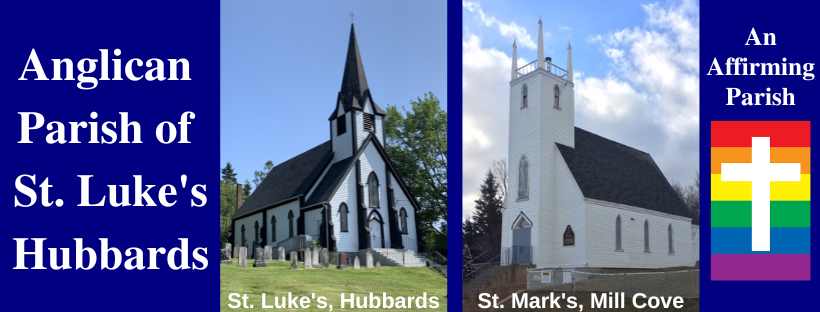The first service, a baptism, was held July 14th, 1850, in the then newly completed Church of St. Luke. With the help of a Diocesan grant the cornerstone was laid in 1848 by the Rev. J. Shreve, Rector of St. Stephen's Church, Chester. At that time, Hubbards Cove was a mission of St. Stephen's Church, and was visited by Rev. Shreve who held services in the Church School and in the home of Capt. John Dauphinee. It was not until 1871 that St. Luke's became an independent parish and the Church consecrated.
Many hands helped bring the parish to this point. Bishop Robert Stanser visited the area in 1822 and found the people attentive to public worship and eager to have a small church of their own. The Rev. J.C. Cochran, however, reported on his visit to the Cove in 1824 that he found many of the 40 large families and 300 souls there 'in a state of gross darkness'. The first resident priest of St. Luke's was the Rev. J. Smith, curate of St. Stephen's Chester. But there was no rectory for him to stay in. When the Rev Henry Stamer arrived from Pugwash, with his wife, daughter of Col James Poyntz, a Waterloo veteran, and their 5 sons and 2 daughters, a place to stay in was a necessity. Fr. Stamer noted the willingness of parishioners to erect a Parsonage House on the elm-lined site provided overlooking the Cove. 'Some of them', he wrote,'I have known to walk 5 miles, bringing with them some bread and a bottle of milk, and at noon sit under a tree and eat it, and then commence working again, without receiving any remuneration for their labour - [In the winter] they cut down trees, hauled them to the sawmill, and in the spring of the year delivered, free of any charge, both the frame and lumber sufficient to board it in.'
The "Parson's House", as it was called, was completed in 1860/61, and the parishioners were proud of it, and their attachment to the Church increased. (note: the current rectory was first occupied in November 1956 by Rev. Sam Miller and his wife Lillian and children) Rectory families provided much of the medical care to the community. Mrs. Stamer is reported to have possessed more than ordinary lay knowledge of medicine. This tradition was carried forward by the Rev. Joseph Norwood. Joseph had gone to sea as a boy of 8, served with the Northern Army in the American Civil War, was wounded several times, and had the scars to prove it. After the war he went as a Missionary to the West Coast of Africa and returned to minister in the Magdalen Islands and various parishes in the Diocese before coming to Hubbards Cove as Rector in 1891. He was noted for his ability as a healer of bodies as a well as souls. The descendants of this remarkable man were also persons of accomplishment in their own right. His son Edmund studied at Dalhousie and received his M.D. and served the community as its doctor for 14 years until his death from influenza Dec. 30th, 1918. Another son, Robert was ordained and served as his father's curate in the parish, and went on to become Rector of St. Bartholome's in New York City. The 100th Anniversary of the Parish, held in 1950, was observed by the reading of its history, illustrated at intervals by the re-enactment of significant events in the life of the church. Dorothea Homans, in costume, introduced the pageant with the song 'Tell Me the Tales'. There was a reading by Miss Grace Conrad, a duet by Miss Homans and Russell MacLean, and another by Ruth Ann Blakney and Joan Sims dressed as clowns. The whole affair was directed by Miss Minnie Dauphinee, with piano accompaniment by Mrs. Guy Harnish. Mrs. Cyril Clerke directed and accompanied the the musical numbers. In addition to this cast, former rectors were in attendance: the Most Rev. G.F. Kingston, Archbishop of Nova Scotia, wearing the Episcopal ring used by Bishop Binney when he held the first confirmation at St. Luke's in 1852; the Rev. C.W.F. Stone, Professor at King's College, Halifax, Victor Cunningham, A.G. Bradshaw, and the Rector of the day W.G. Meadus.
The Rev. Henry Stamer, born in Northern Ireland, came to the parish from Pugwash, and served for 30 years as Rector here. During this time a Rectory was constructed and the momentum that resulted in the construction of a second church began to grow. The building of a Church school in Northwest Cove further down the shore may have provided impetus for the people of Mill Cove to begin work themselves. A lot was first purchased in 1864 from John Jollymore and William Cyrus Jollymore, for use as a cemetery. Philip Harnish and George Jollymore were among those who promoted the project of a new Church. Work began in early 1889, and was completed by September of that year. The Church stood on footings of stone hand cut by William Jollymore, and the plaster for the interior walls was mixed by John Harnish. The people of Mill Cove were helped in their undertaking by the interest and gifts of friends in other communities. In 1890, an excursion ship from Halifax arrived with visitors who took part in one of the 2-3 day picnics held to raise funds. Josiah Harnish and Simeon Johnson rowed a 16 ft. boat to Indian Harbour and Tancook Island and back seeking donations. Under the rector the Rev. C.W.F. Stone, who later became Divinity Professor at King's College, Halifax, a St. Mark's Boys' Club was formed. A Church Hall for the club was planned, with the wood for it cut from Si Harnish's land, and cut into lumber by Stanley Harnish. However the Hall was not built.
